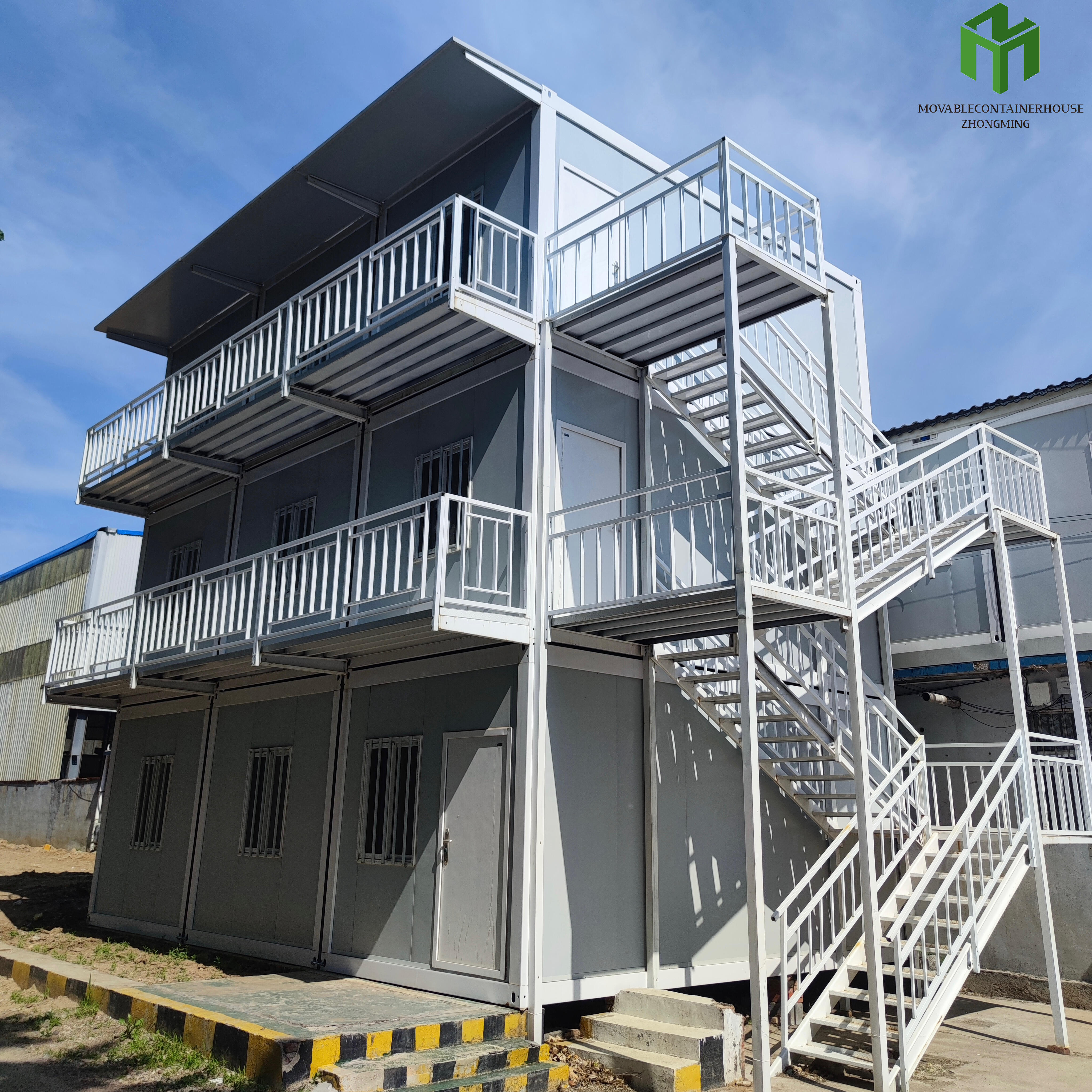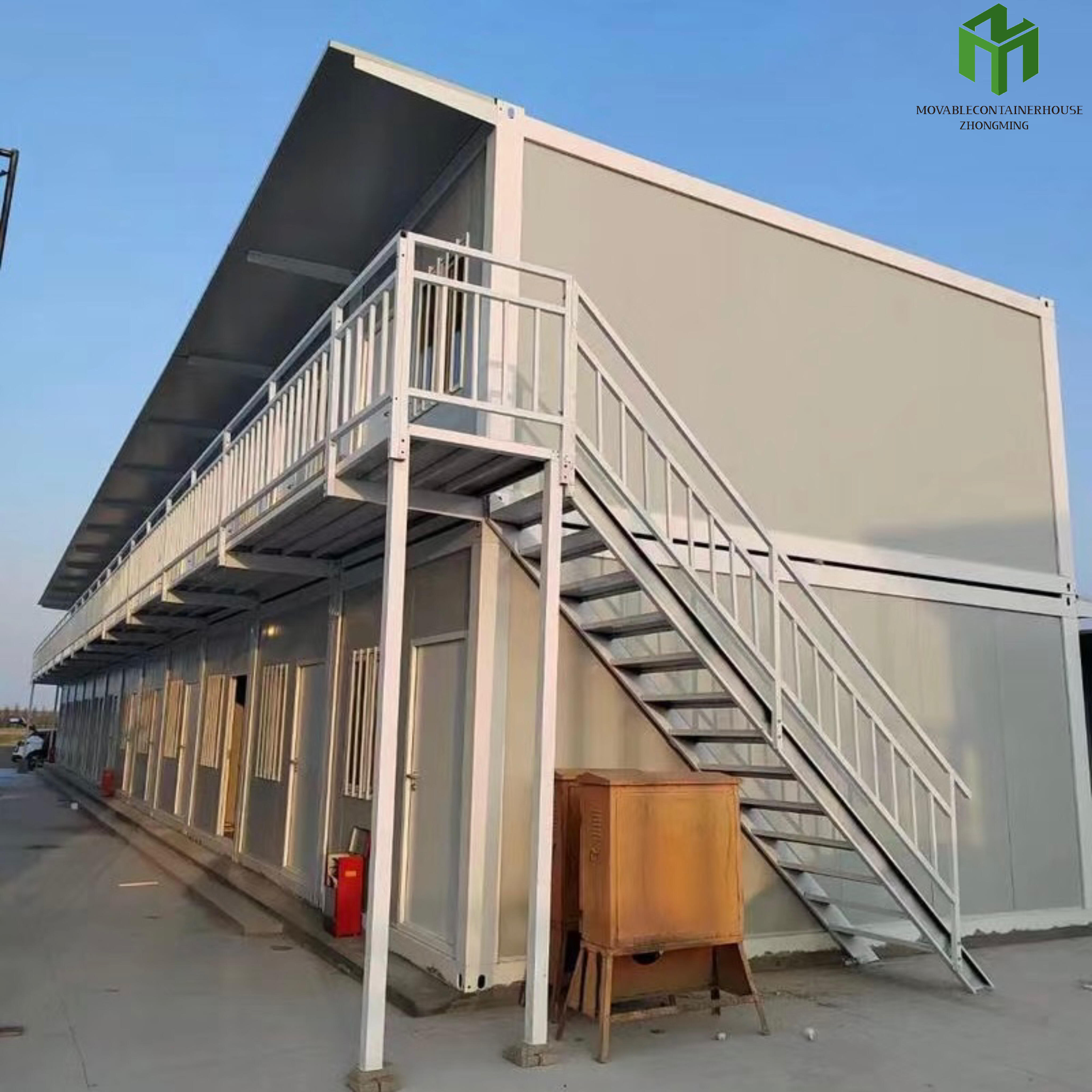कंटेनर होम आर्किटेक्चर के माध्यम से स्थायी जीवन जीने को अपनाना
आंदोलन स्थायी आवास समाधानों की ओर एक नवीन दृष्टिकोण की ओर ले जाता है जो हमारे आधुनिक रहने के स्थानों के बारे में सोच को बदल रही है। कंटेनर हाउस जीवन शैली आवासीय वास्तुकला में एक उल्लेखनीय बदलाव का प्रतिनिधित्व करती है, जो पर्यावरण चेतना को व्यावहारिक जीवन शैली के साथ जोड़ती है। जैसे-जैसे अधिक लोग अपने कार्बन फुटप्रिंट को कम करने के तरीकों की तलाश कर रहे हैं, जबकि आरामदायक जीवन मानकों को बनाए रखते हैं, शिपिंग कंटेनर घरों ने एक आकर्षक समाधान के रूप में उभर कर सामने आया है जो पर्यावरण संबंधी चिंताओं और आधुनिक आवास आवश्यकताओं का समाधान करता है।
शिपिंग कंटेनरों को घरों में बदलना केवल एक प्रवृत्ति नहीं है – यह स्थायी रहन-सहन के लिए एक व्यापक दृष्टिकोण है जो कई पर्यावरण संबंधी लाभ प्रदान करता है। एक समय ये स्टील संरचनाएं समुद्रों के पार माल ढुलाई के लिए उपयोग की जाती थीं, अब ये पर्यावरण के अनुकूल आवास के रूप में नई जान ले रही हैं, जो पारंपरिक आवास परंपराओं को चुनौती दे रही हैं और पर्यावरण संरक्षण को बढ़ावा दे रही हैं।

सामग्री की संरक्षण और अपशिष्ट कमी
औद्योगिक सामग्री का पुन: उपयोग
एक अपनाए गए कंटेनर हाउस जीवन शैली के पीछे सबसे महत्वपूर्ण पर्यावरणीय लाभों में से एक पुन: उपयोग की मूलभूत अवधारणा है। आवास के लिए फिर से उपयोग किए गए प्रत्येक शिपिंग कंटेनर से लगभग 3,500 किग्रा स्टील को कचरा स्थल में जाने से रोका जाता है। यह अनुकूलित पुन: उपयोग दृष्टिकोण औद्योगिक कचरे को मूल्यवान रहने योग्य जगहों में बदल देता है, जो क्रियान्वित पुनर्नवीनीकरण अर्थव्यवस्था सिद्धांतों का एक उत्कृष्ट उदाहरण प्रस्तुत करता है।
निर्माण उद्योग पारंपरिक रूप से अपशिष्ट की बहुत अधिक मात्रा उत्पन्न करता है, लेकिन कंटेनर घर इस पर्यावरणिक बोझ को काफी हद तक कम कर देते हैं। मौजूदा संरचनाओं का उपयोग करके, कंटेनर घर के निर्माण में आम तौर पर पारंपरिक घर निर्माण की तुलना में 80% कम नए निर्माण सामग्री की आवश्यकता होती है।
निर्माण अपशिष्ट को कम करना
कंटेनर घरों की मॉड्यूलर प्रकृति के कारण सामग्री की सटीक आवश्यकताओं के परिणामस्वरूप निर्माण अपशिष्ट में काफी कमी आती है। पारंपरिक निर्माण के विपरीत, जहां अक्सर अतिरिक्त सामग्री भूसे में जाती है, कंटेनर घर संशोधनों की योजना असाधारण सटीकता के साथ बनाई जा सकती है। सामग्री के उपयोग में यह सटीकता न केवल अपशिष्ट को कम करती है, बल्कि लागत बचत और अधिक कुशल संसाधन उपयोग भी करती है।
इसके अतिरिक्त, शिपिंग कंटेनरों के मानकीकृत आयाम नवीकरण प्रक्रिया के दौरान सरल योजना और न्यूनतम सामग्री अपशिष्ट की अनुमति देते हैं। खिड़कियों या दरवाजों से कट-आउट को अक्सर आंतरिक तत्वों के लिए फिर से उपयोग किया जा सकता है, जिससे अपशिष्ट में और कमी आती है।
ऊर्जा कुशलता और कार्बन पैदावार कमी
उत्कृष्ट इन्सुलेशन क्षमताएं
आधुनिक कंटेनर घर उचित इन्सुलेशन तकनीकों के माध्यम से उल्लेखनीय ऊर्जा दक्षता प्राप्त कर सकते हैं। कंटेनर संरचनाओं की सघन प्रकृति, उच्च-प्रदर्शन वाली इन्सुलेशन सामग्री के साथ, एक उत्कृष्ट थर्मल आवरण बनाती है। इससे हीटिंग और कूलिंग के लिए ऊर्जा की खपत में कमी आती है, जिससे ग्रीनहाउस गैस उत्सर्जन में कमी आती है।
उचित रूप से इन्सुलेटेड होने पर, कंटेनर घर कम ऊर्जा इनपुट के साथ आरामदायक आंतरिक तापमान बनाए रख सकते हैं। स्टील निर्माण में स्थायी इन्सुलेशन सामग्री, जैसे कि रीसाइकल डेनिम या शीप्स वूल के आसान एकीकरण की भी अनुमति देता है, जो पर्यावरणीय लाभों को और बढ़ाता है।
अक्षय ऊर्जा प्रणालियों का एकीकरण
कंटेनर हाउस जीवन शैली स्वाभाविक रूप से नवीकरणीय ऊर्जा समाधानों के साथ पूरक होती है। कंटेनरों की सपाट छत की सतह सौर पैनल स्थापना के लिए आदर्श मंच प्रदान करती है, जबकि उनकी मजबूत निर्माण संरचना पवन ऊर्जा प्रणालियों को समर्थन दे सकती है। कई कंटेनर घर निवासी इन स्थायी ऊर्जा स्रोतों के माध्यम से ऊर्जा स्वतंत्रता प्राप्त करना आसान पाते हैं।
कंटेनर घरों का संकुचित क्षेत्रफल यह भी सुनिश्चित करता है कि जलवायु नियंत्रण के लिए कम ऊर्जा की आवश्यकता होती है, जिससे पूर्णतः नवीकरणीय ऊर्जा पर संचालन करना अधिक सुविधाजनक हो जाता है। पारंपरिक ऊर्जा खपत में इस कमी से कंटेनर घर के निवासियों के कार्बन फुटप्रिंट में काफी कमी आती है।
जल संरक्षण और स्थायी प्रणाली
कुशल जल प्रबंधन
कंटेनर घर नवीन डिज़ाइन विशेषताओं के माध्यम से जल संरक्षण में उत्कृष्टता दर्शाते हैं। वर्षा जल संग्रहण प्रणालियों को संरचना में आसानी से एकीकृत किया जा सकता है, क्योंकि कंटेनरों के एकरूप आकार से संग्रह और भंडारण प्रणालियों की स्थापना सरल हो जाती है। इस प्रकार संगृहीत जल का उपयोग सिंचाई, सफाई और अन्य गैर-पीने योग्य उद्देश्यों के लिए किया जा सकता है।
कई कंटेनर हाउस लाइफस्टाइल अपनाने वाले ग्रे वाटर सिस्टम भी लागू करते हैं, जिससे सिंक और शावर से निकलने वाले पानी को फ़िल्टर करके बगीचे के लिए दोबारा उपयोग किया जा सके। ये पानी बचाने वाले उपाय दैनिक पानी की खपत के पर्यावरणीय प्रभाव को काफी कम करते हैं।
स्थायी पाइप लाइन समाधान
कंटेनर घरों की संकुचित डिज़ाइन पानी-कुशल फिटिंग और उपकरणों की स्थापना को बढ़ावा देती है। लो-फ्लो नल, डुअल-फ्लश शौचालय और पानी बचाने वाले शावरहेड मानक सुविधाएं बन जाते हैं, जो स्थायी पानी के उपयोग का समर्थन करते हैं। कंटेनर घर का नियंत्रित वातावरण पानी की खपत के पैटर्न की निगरानी और इष्टतम बनाना आसान बनाता है।
कंटेनर घर वैकल्पिक अपशिष्ट प्रबंधन प्रणालियों, जैसे कि कम्पोस्टिंग शौचालय और प्राकृतिक फ़िल्टरेशन प्रणालियों के लिए भी अच्छी तरह से उपयुक्त हैं, जो पर्यावरणीय प्रभाव और पानी के उपयोग दोनों को कम करते हैं।
भूमि उपयोग और पारिस्थितिक प्रभाव
न्यूनतम स्थल विक्षोभ
कंटेनर हाउस जीवन शैली प्राकृतिक भू-दृश्यों में न्यूनतम बाधा उत्पन्न करती है। इन घरों में पारंपरिक निर्माण की तुलना में कम व्यापक नींव का कार्य आवश्यकता होती है, जिससे मिट्टी के विक्षोभ में कमी आती है और स्थानीय पारिस्थितिकी तंत्र का संरक्षण होता है। कंटेनर घरों को आसानी से स्थानांतरित करने की क्षमता यह भी सुनिश्चित करती है कि भूमि पर उनका स्थायी प्रभाव न्यूनतम रहे।
कंटेनर घरों का संकुचित क्षेत्र अधिक हरित स्थान संरक्षण की अनुमति देता है, जो स्थानीय जैव विविधता और प्राकृतिक आवास के संरक्षण का समर्थन करता है। आवास की यह पद्धति दर्शाती है कि मानव आवास प्राकृतिक वातावरण के साथ सामंजस्यपूर्ण ढंग से कैसे अस्तित्व में रह सकता है।
विविध स्थापना विकल्प
कंटेनर घरों को प्राकृतिक प्रकाश एवं वेंटिलेशन को अधिकतम करने के लिए रणनीतिपूर्वक स्थापित किया जा सकता है, जिससे ऊर्जा आवश्यकताओं में कमी आती है। इनकी अनुकूलनीय प्रकृति उन्हें भूमि की प्राकृतिक विशेषताओं का लाभ उठाकर स्थापित करने की अनुमति देती है, जो निष्क्रिय तापन और शीतलन के लिए है, जिससे पर्यावरणीय प्रभाव में और कमी आती है।
स्थिति निर्धारण में लचीलेपन के कारण कंटेनर घरों को शहरी वातावरण में भी आसानी से शामिल किया जा सकता है, जिससे घनत्व बढ़ता है बिना किसी नए निर्माण या बुनियादी ढांचे के विस्तार की आवश्यकता के।
अक्सर पूछे जाने वाले प्रश्न
कंटेनर घर आमतौर पर कितने समय तक टिकते हैं?
उचित रखरखाव और जंग से सुरक्षा के साथ, कंटेनर घर 25 वर्ष या उससे अधिक समय तक टिक सकते हैं। स्टील की संरचना की स्थायित्व, नियमित रखरखाव और गुणवत्ता युक्त संशोधनों के साथ एक लंबे समय तक चलने वाला और स्थायी आवास समाधान सुनिश्चित होता है।
कंटेनर घरों के लिए किस प्रकार के इन्सुलेशन सबसे अच्छे काम आते हैं?
कंटेनर घरों के लिए स्प्रे फोम इन्सुलेशन बहुत प्रभावी है, जो उत्कृष्ट थर्मल प्रदर्शन और नमी नियंत्रण प्रदान करता है। अन्य स्थायी विकल्पों में रीसाइकल किया डेनिम, भेड़ की ऊन, और कॉर्क इन्सुलेशन शामिल हैं, जो पर्यावरण के अनुकूल होने के साथ-साथ आराम को बनाए रखने की क्षमता भी रखते हैं।
क्या कंटेनर घर पूरी तरह से ऑफ-ग्रिड हो सकते हैं?
हां, कंटेनर घरों को पूरी तरह से ऑफ-ग्रिड जीवन के लिए डिज़ाइन किया जा सकता है। सौर ऊर्जा प्रणालियों, वर्षा जल संग्रह, खाद बनाने वाले शौचालयों और ऊर्जा-कुशल उपकरणों के एकीकरण के माध्यम से, कंटेनर घर पारंपरिक उपयोगिता प्रणालियों से स्वतंत्र रूप से संचालित हो सकते हैं, जबकि आधुनिक सुविधाओं को बनाए रखते हैं।
कार्बन फुटप्रिंट के मामले में कंटेनर घरों की तुलना पारंपरिक घरों से कैसे की जाती है?
आम तौर पर कंटेनर घरों का पारंपरिक घरों की तुलना में कार्बन फुटप्रिंट काफी कम होता है। मौजूदा सामग्री का पुन: उपयोग, निर्माण अपशिष्ट में कमी, ऊर्जा-कुशल डिज़ाइन और छोटे आकार सभी कार्बन उत्सर्जन में काफी कमी में योगदान देते हैं।


